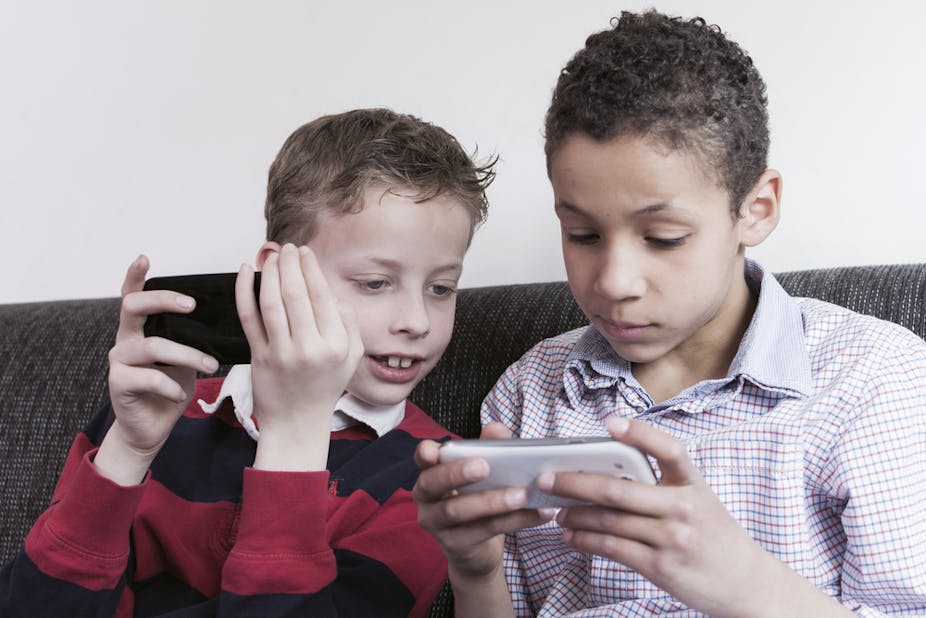The bond between a child and their smartphone is like an umbilical cord. Now, a new survey has uncovered just how dependent the “smartphone generation” of British children are on the devices compared to their European counterparts.
The new survey used 2013 data from Net Children Go Mobile project of 3,500 children across Europe, combined with in-depth interviews, to examine how British children’s use of technology had changed since a previous survey in 2010.
Smartphones have now become the most common device through which British children go online: 56% of the 516 British 9-16-year-olds surveyed use them to do so every day. This is more than the European average of 45%. In Britain, the numbers increase with age, as the graph below shows.

PCs still trump for games
By comparison with British children surveyed in the 2010 EU Kids Online survey, children’s use of PCs to go on the internet has halved, although laptop access has held up at 47%.
Interviews with children indicate that for some uses such as playing online games or looking up material for homework, the larger screens and greater processing power still have some advantages. As a result, young people use a variety of devices to go online: tablets, video consoles, even eBook readers. In fact, UK children use a broader range than the European average.
For instance, 16-year-old Alan told us he prefers to go on the PC for many tasks – the graphics quality for playing games is better, and he can type faster on a keyboard. But even he says it is more comfortable to lie in bed watching YouTube on his smartphone.
When 13-year-old Anuj wants to look up something that catches his attention, he pulls the smartphone out of his pocket because he can’t be bothered to go upstairs and boot up his computer. Meanwhile, ten-year-old Genna and her friends are using their smartphones to work their way through over 200 games on the site Friv.
These examples illustrate an intriguing finding that most smartphone use is actually at home. But perhaps it’s not so strange when you think that one of the major places where children have historically used more traditional mobile phones has been in the home.
For children, mobiles and smartphones are personal phones, which are with them, or at least at hand, even in the home. Whereas parents can impose spending limits on their children’s data consumption outside the home, using smartphones at home is free on the home wifi. Adults follow these same patterns – but are arguably less conscious about their own data usage outside a home wifi zone.
The smartphone is the most expensive item most children have ever carried around with them on a regular basis. No wonder that parents and teachers advise them to be wary, or at least discrete, about using smartphones in public for fear of theft – advice which many children, especially the younger ones, do heed.
Yet there has only been a muted public debate about the use of smartphones in schools. It seems to be very much a decision for individual schools. Overall, UK schools appear to limit their use quite a lot, as 63% of children in our survey reported that smartphone use is not allowed, and 33% say it is allowed with restrictions.
One can understand the potential for distraction in class time, but children we interviewed reported unsanctioned use in breaks. In fact, 25% of the 516 children we surveyed reported going online on their smartphones daily at school.
When so many appear to break the rules, maybe it is time to reassess the situation. Certainly schools in other countries make different decisions. In Denmark, 70% of children can use their smartphones in schools without any restrictions.
Dependent, but aware of risks
So what effects has the smartphone had? Children who use them do more of everything online (although this may be in part because children who are more enthusiastic about the internet are keener to get hold of a smartphone in the first place.) But in interviews, many children also said they felt they did more online because the portable device was so convenient.
On the downside, smartphone users were more likely to be overdependent: 78% acknowledged that their internet use meant they spend less time than they should with family, friends or doing schoolwork. This excessive use was greater than for the other European countries, where the average for excessive use was 61%.
That said, the young people were generally very positive about smartphones, with 59% saying they felt more connected to their friends as a result of using them. The 2010 survey had shown that those who use the internet more in general also encountered more risks – such as cyberbullying, meeting strangers or pornography – but they were no more likely to say it upset them. Basically the same is true of smartphones. Children who used smartphones experienced more risks, but not more harm. Arguably taking risks is part of learning about the online world, part of learning to cope – and part of growing up.

